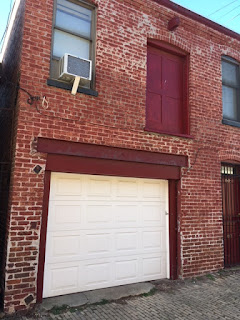Staring out at the city skylights
A marathon is going down the street
And we're all racing for our own reasons
And sometimes in the middle we all meet
--"MARATHON," HEARTLESS BASTARDS (w/m Erika Wennerstrom)
Last weekend was the Rock n Roll Marathon in Washington, much anticipated after weeks of seeing notices like this:
The route went down East Capitol Street from Lincoln Park to 3rd Street, passing little more than a block from our apartment. It was fortuitously one of the nicer days we've had of late. I walked along the route for a little while. Crowds in the neighborhood were not thick, but runners were enthusiastically greeted by small children and their parents:
In time, more runners appeared:
There was considerable police presence, to manage traffic. On 5th Street, where we live, cars were blocked below A Street.
Other officers blocked the intersections with East Capitol Street.
Cars were allowed across on the busier thoroughfares, like 4th, 6th and 8th Streets.
Skilled and alert officers looked for breaks in the clots of runners, and when they came, urgently waved across a vehicle or two, yelling if necessary if the driver's concentration had lapsed and wasn't paying attention.
I don't know how I would assess this. It drew 17,000 runners and raised money for St. Jude's Children's Research Hospital. (See coverage on Runner's Web here.) It was a special event for at least some residents, though I don't know if it was a huge community-builder. News photos did show more people at the start and finish lines near RFK Stadium, and probably near music stages as well. The marathon required an extraordinary marshaling of law enforcement officers, which I hope someone besides the taxpayers paid for, and clearly involved some disruption to usual parking and traffic patterns. How does all that balance out?
We've also been finding out about our neighborhood. Thursday night we attended a talk at the Hill Center by Kim Prothro Williams of the DC Historic Preservation Office on "Historic Alleyways and Alley Buildings of Capitol Hill."
I've mentioned alley dwellings in my last "letter" where I talked about corner stores. In Capitol Hill and Georgetown, among other parts of the city, they're a stylish way to achieve the population density that supports a walkable neighborhood.
 |
| Alley buildings, Miller's Court NE |
- The original (1793-96) alleys were designed as back routes for large lots, and to provide space for accessory dwellings and functional purposes like stables, warehouses, workshops and studios. This accounts for their distinctive shape, which she said is unique at least in the United States. Rather than one straight drive with buildings on either side, there's a narrow access way that opens into a fairly large space I would describe as bone-shaped. Some, like the alley behind the house where we're living, have only one way in and out!
- In the 1850s a dramatic increase in population led to the subdividing of these large lots to create working-class housing, with row houses facing the street and smaller dwellings facing the alleys. The alley dwellings tended to be of low quality, basically tenements although she didn't use the word. Reformers struck repeatedly at the unsanitary conditions, resulting in condemnations of alley dwellings or conversions to garages or stables (as well as the loss of what were close-knit communities in spite of conditions). Another influx of population, after World War II, put a stop to that process. Many surviving alley dwellings were renovated, and even new ones were built. Brown's Court SE contains buildings from the 19th century, the 1960s and the 1980s.
- Besides the little collections of small houses, Capitol Hill's historic alleys contain a number of surviving historic buildings, or "contributing structures" in preservation lingo, including collections of stables (which of course are being used for other things now). Right around our apartment is a coach shop from 1911, a stable from 1911, a stable big enough to be a commercial operation from 1896, a Locomobile shed from 1902, and the only surviving one-story stable in the District which was built in 1885.

 |
| Locomobile shed (1902) |
 |
| Large stable (1896) |
Knowing more about the neighborhood's history makes me look at the built environment differently!
SEE ALSO
Kim Prothro Williams, The DC Historic Alley Building Survey (DC Historic Preservation Office, 2014)
David Salter, Preserving DC Stables blog












No comments:
Post a Comment